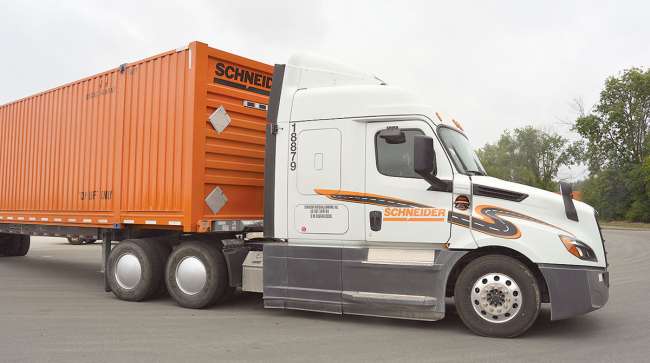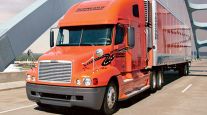Staff Reporter
Schneider Q3 Profit Slumps, Misses Analyst Expectations

[Stay on top of transportation news: Get TTNews in your inbox.]
Profits at Schneider in the third quarter of 2023 slumped 72% year-over-year in what the company believes was the most challenging phase of the ongoing freight recession, including steep fuel price hikes.
The truckload and intermodal carrier posted net income of $35.6 million or diluted earnings per share of 20 cents in Q3, compared with $125.8 million, 70 cents, in the same period a year earlier, the company said Nov. 2.
Green Bay, Wis.-based Schneider posted operating revenue of $1.352 billion in the most recent quarter, a 19% decline compared with $1.675 billion in the year-ago period.
Schneider fell short of consensus analyst expectations. Analysts expected EPS of 38 cents and revenue totaling $1.4 billion, according to Zacks Equity Research.
As a result of the weak freight environment, Schneider cut its full-year earnings guidance. The company’s full-year 2023 adjusted diluted EPS is now $1.40-$1.45, versus $1.75-$1.90 previously.
“Our second-half 2023 earnings are clearly challenged by ongoing pricing pressures, muted seasonality and transitory cost items,” Chief Financial Officer Darrell Campbell said in the company’s earnings statement.
“We are intently focused on margin restoration, particularly in our network businesses, which includes the proactive execution of pricing strategies and positioning our enterprise for improving market conditions, which we expect to materialize in the first half of 2024,” he added.
In response to the cut in guidance, JPMorgan Chase & Co. analyst Brian Ossenbeck said, “The negative revisions are consistent with our theme from the year that the 2023 earnings trough would be deeper than expected, but the magnitude of the decline has been surprising.”
The company’s share price slumped after the Q3 results were released. The stock was quoted at $25.36 when trading closed Nov. 1 but closed just above $22 a share Nov. 2. The share price was little changed in the first couple of hours of Nov. 3.
Schneider ranks No. 8 on the Transport Topics Top 100 list of the largest for-hire carriers in North America and No. 20 on the Transport Topics Top 100 list of the largest logistics companies.
Schneider’s largest division is its truckload operation, which is divided into two units: Dedicated, which involves transportation services with equipment devoted to customers under long-term contracts, and Network, or transportation services for one-way shipments.
Truckload revenues, excluding fuel surcharges, totaled $535.3 million in the third quarter, a decrease of 6% compared with $571.2 million in the same quarter in 2022.
The decline was driven by unfavorable pricing for Network activities, which was partially offset by the impact of organic Dedicated growth and revenues from newly acquired M&M Transport, the company said. The impact of productivity improvements were more than offset by pricing declines, Schneider added.
Truckload revenue per truck per week was $3,909, a year-over-year decrease of 6% compared with $4,178. Revenue per truck per week for the company’s Network operations decreased 16% year-over-year to $3,795, while revenue per truck per week at the Dedicated unit increased 2% to $3,986.
Volvo's Keith Brandis and Eric Bond take an in-depth look at how the company's SuperTruck 2 improves freight efficiency. Tune in above or by going to RoadSigns.ttnews.com.
The Truckload unit’s operating ratio was 95.4 in Q3, compared with 85.4 in the year-ago quarter. Operating ratio provides insight on how a company is doing in balancing its costs and revenue generation. The lower the ratio, the better a company’s performance.
Bank of America Securities analyst Ken Hoexter said the Truckload operating ratio was 5.8 percentage points worse than he expected, and the worst ever seen by the unit.
Intermodal revenues, excluding fuel surcharges, in Q3 totaled $263 million, a decrease of 21% compared with $334.7 million a year earlier. The company said this was because of lower revenue per order and volume, which decreased 16% and 9% year-over-year, respectively. The Intermodal operating ratio was 95.8 in Q3, compared with 90.7 a year earlier.
“Our enterprise experienced year-over-year declines in revenue and earnings in the third quarter, a period which we believe represents the most challenging phase of this prolonged freight recession,” CEO Mark Rourke said in the earnings statement.
During the company’s analyst earnings call Nov. 2, Rourke added: “As we’ve seen for the better part of the year, freight volumes remain muted, and while inventories have normalized, shippers are facing an uncertain macro outlook.”
“We expected the quarter to be challenging, and it certainly was as the forceful impacts of pricing resets were realized, especially in our network offerings of truck and Intermodal,” he told analysts.
Want more news? Listen to today's daily briefing above or go here for more info
In addition to weak freight markets, Schneider took a hit from fuel prices, which normally have a neutral impact on the company’s results.
“We typically do not talk about fuel, as over the course of time, fuel has a relatively neutral effect on our earnings. However, it was a notable negative factor in the third quarter of ’23 compared to the prior quarter due to the rapid run-up in fuel costs,” Rourke said.
Looking forward, things will improve on fuel, but not get much better overall, according to outgoing CFO Steve Bruffett. “We expect fuel to be neutral to slightly positive [in Q4] rather than negatively impacting earnings as it did in the third quarter,” he said.
Overall, “we expect the continuation of current market conditions, and therefore, are assuming little to no seasonal lift from volumes or project activity,” Bruffett said.
The first three months of 2024 are unlikely to be much better.
“I think in our earlier comments, we suggested 2024 being a year of transition,” Bruffett said. “And I think that from what we can see sitting here today, there probably would be a sluggish start to the year. You never know, something often happens once you switch from December to January and find yourself in a different arena.
“So, I think the first quarter itself of 2024 will probably be a bit more of the same, but we do believe that there’s an upward ramp that begins as we begin to exit that first quarter.”
Executives expect contract rates in particular to improve in the first three months of next year, which analysts were positive about.
“Schneider has been one of the more cautious management teams in terms of forecasting a recovery so far in 2023, which is why we believe the outlook for positive contract rates next year was a key part of the earnings call today,” Ossenbeck said.
“Schneider sounded more constructive on the outlook compared to peers, which is noteworthy considering the company was relatively more cautious” in the first half of 2023, said Ossenbeck, adding that in a follow-up call, executives said conversations with large shippers found them recognizing that the truckload market will not stay this soft indefinitely and looking to secure capacity before the shift.





